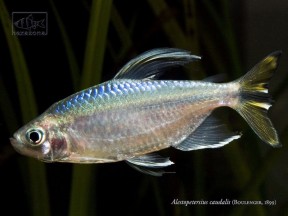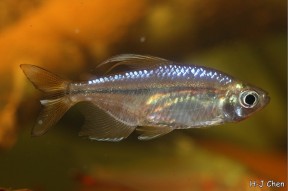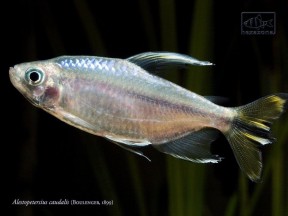Alestopetersius caudalis
Yellow-Tailed Congo Tetra, Yellow Congo Tetra, Gelber Kongosalmler (DE)
SynonymsTop ↑
Petersius caudalis Boulenger, 1899; Petersius brumpti Pellegrin, 1906; Petersius xenurus Boulenger, 1920; Micralestes grandi Fowler, 1936
Etymology
Alestopetersius: etymology not explained, but appears to be a combination of Alestes (type genus of the family Alestidae) and Petersius (original genus of the type species A. hilgendorfi).
caudalis: from the Latin caudalis, meaning ‘of the tail’, probably in reference to the silvery lateral band that becomes blackish on the caudal peduncle and extends onto the caudal fin.
Classification
Order: Characiformes Family: Alestidae
Distribution
Type locality is ‘Boma, Lower Congo River, Democratic Republic of Congo’, and this species has been recorded throughout much of the lower Congo region and upriver beyond Pool Malebo (Stanley Pool) at least as far as the Irebu channel, the principal outflow of Lake Tumba in the Middle Congo, Équateur province, northwestern Democratic Republic of the Congo.
Habitat
Little has been written about the natural habitat or biology of any Alestopetersius species.
In Lake Tumba and surrounding waters other alestids include Micralestes acutidens, M. congoensis, M. humilis, Bathyaethiops caudomaculatus, Phenacogrammus deheyni, P. altus, Alestopetersius hilgendorfi, A. leopoldianus, A. cf. tumbensis and Tricuspidalestes caeruleus.
Maximum Standard Length
50 – 60 mm.
Aquarium SizeTop ↑
Minimum base dimensions of 120 ∗ 30 cm or equivalent are recommended.
Maintenance
Décor is relatively unimportant and this species will do well in planted aquaria but ideally the aquarium should be designed to resemble a flowing stream or river with a substrate of variably-sized rocks, sand, fine gravel, and some larger water-worn boulders.
This can be further furnished with driftwood roots and branches being sure to leave plenty of open swimming space.
Water Conditions
Temperature: 22 – 26 °C
pH: 5.0 – 7.5
Hardness: 36 – 268 ppm
Diet
Wild fish are probably foragers feeding on small insects, crustaceans, fallen fruit, etc.
In the aquarium it’s easily-fed but the best condition and colours offer regular meals of small live and frozen foods such as bloodworm, Daphnia, and Artemia alongside good quality dried flakes and granules, at least some of which should include additional plant or algal content.
Behaviour and CompatibilityTop ↑
Lively and somewhat skittish but generally peaceful making it an ideal resident of the well-researched, larger community aquarium.
Fishes inhabiting similar environments in nature, especially comparably-sized cyprinids and other alestids perhaps constitute the best choices but other options include many cichlids, catfishes, loaches, etc.
Try to buy at least 8-10 specimens including both males and females, add other schooling fishes to provide security, and you’ll be rewarded with a more natural-looking spectacle.
The interaction between rival males is also interesting to watch and they will display their best colours when competing for female attention or hierarchical position within the group.
Several males may take part in such battles simultaneously which can make for some spectacular displays.
If space is limited males are more likely to injure each other with a loss of body scales particularly common, and the resultant wounds can be susceptible to infection.
Sexual Dimorphism
Adult males are more colourful and tend to grow larger than females.
Males also develop extended, white-tipped dorsal, ventral, anal and caudal fins which females lack.
Reproduction
Does not appear to be bred with any regularity in the aquarium hobby since few details are available.
It’s an egg-scatterer exhibiting no parental care, and one method of breeding it is apparently to keep a group of adults in their own aquarium furnished with an artificial trap of some kind, checking this as regularly as possible for eggs.
These are removed and normally hatched in smaller containers with the fry being offered microscopic foods until large enough to accept Artemia nauplii and suchlike.
NotesTop ↑
This species is also traded as ‘yellow-finned’, ‘yellowtail’ or ‘blue Congo’ tetra and is occasionally bred on a commercial basis, although not on a scale comparable to its better-known relative Phenacogrammus interruptus.
No recent key to the genus exists but based on Géry (1977) and images in Mbimbi Mayi Munene and Stiassny (2012) it can be told apart from congeners by a combination of: extended median caudal-fin rays in adult males; absence of prominent dark bands in the caudal-fin lobes; a vertically-elongate humeral spot; a relatively narrow dark lateral stripe extending onto the caudal-fin where it is significantly broader; humeral spot and lateral stripe more prominent in preserved specimens.
Alestopetersius was first raised by Hoedeman (1951) to contain certain former members of the genus Petersius (now comprising just a single species, P. conserialis) but was later considered a synonym of Hemigrammopetersius Pellegrin 1926 by Géry (1977).
No modern diagnosis of the grouping has been published with recent authors tending to follow the concepts of alestid genera outlined by Poll (1967) in order to maintain taxonomical stability in the absence of comprehensive studies.
The majority of Alestopetersius species are native to the Congo River system with A. smykalai the exception being known only from the Imo and Niger drainages in Nigeria.
The family Alestidae is the most speciose of the African characiform families with well over 100 recognised members.
Most occur in sub-Saharan waters with the greatest diversity to be found in the Congo River system, lower Guinea and coastal rivers of western Africa.
Alestids were formerly included in the family Characidae before being moved to their own grouping by Géry (1977) and range in size from the giant, piscivorous goliath tigerfish, Hydrocynus goliath, to tiny micropredators such as Lepidarchus adonis.
Alestidae was originally split into the subfamilies Hydrocyninae (containing the genus Hydrocynus) and Alestinae (containing all other alestids), but monophyly of these was strongly-rejected by later studies.
More recently, a system whereby the family is comprised of three putative tribes based on dental morphology has been favoured for practical convenience, and these groupings are diagnosed as follows (Schaefer, 2007):
– the genus Hydrocynus characterised by strong, caniniform, mostly conical teeth.
– the genera Alestes, Brycinus and Bryconaethiops (the Alestiini sensu stricto) characterised by more modest, pluricuspid teeth with the inner row of premaxillary teeth molariform.
– all remaining alestid genera (the Petersiini) characterised by smaller adult size and reduced pluricuspid teeth, with the inner row of premaxillary teeth typically not molariform.
Following this system Alestopetersius would be included in the latter and it was recovered to be most closely-related to the genera Duboisialestes, Nannopetersius and Phenacogrammus in the phylogenetic analyses of Zanata and Vari (2005) who also considered the neotropical genus Chalceus to be a member of Alestidae and revalidated the genus Bryconalestes (Hoedeman, 1951) for the species previously assigned to the ‘longipinnis-group’ within Brycinus.
In the more recent molecular study by Arroyave and Stiassny (2011) Alestopetersius was found to be paraphyletic based on its placement with respect to members of the genera Duboisialestes and Tricuspidalestes, while Nannopetersius and Phenacogrammus were recovered as more distant relatives.
The latter authors also removed Chalceus and Arnoldichthys from the Alestidae in order to retain monophyly of the group.
Mbimbi Mayi Muneni and Stiassny (2012) synonymised Duboisialestes with Alestopetersius, the two having formerly been separated based on dentition.
References
- Arroyave, J. and M. L. J. Stiassny, 2011 - Molecular Phylogenetics and Evolution 60(3): 385-397
Phylogenetic relationships and the temporal context for the diversification of African characins of the family Alestidae (Ostariophysi: Characiformes): Evidence from DNA sequence data. - Géry, J., 1977 - T.F.H. Publications, Inc.: 1-672
Characoids of the World. - Mbimbi Mayi Munene, J. J. and M. L. J. Stiassny, 2012 - Zootaxa 3166: 59-68
A new Alestopetersius (Characiformes: Alestidae) from the Kwilu River (Kasai basin) of central Africa; with a phylogeny for the genus and synonymy of Duboisialestes. - Paugy, D., 1990 - ORSTOM, Paris: 195-236
Characidae. In: Lévêque, C., D. Paugy and G. G. Teugels. (Eds), Faune des Poissons d'eaux Douce et Saumâtres de l'Afrique de l'Ouest Vol. 1. - Paugy, D., 1990 - Ichthyological Exploration of Freshwaters 1(1): 75-84
Note à propos des Petersiini (Teleostei: Characidae) d'Afrique occidentale. - Paugy, D. and S. A. Schaefer, 2007 - IRD Éditions, Paris: 349-411
Alestidae. In: Stiassny, M. L. J., G. G. Teugels and C. D Hopkins. (Eds), The Fresh and Brackish Water Fishes of Lower Guinea, West-Central Africa. - Paugy, D., C. Lévêque and G. G. Teugels, 2003 - IRD Éditions, Publication scientifiques du Muséum, MRAC: 1-457
The Fresh and Brackish Water Fishes of West Africa Volume 1 - Stiassny, M. L. J. and S. A. Schaefer, 2005 - Ichthyological Exploration of Freshwaters 16(3): 271-278
Rhabdalestes aeratis, new species (Characiformes: Alestidae): first occurrence of the genus from the Middle Congo River basin. - Zanata, A. M. and R. P. Vari, 2005 - Zoological Journal of the Linnean Society 145: 1-144
The family Alestidae (Ostariophysi, Characiformes): a phylogenetic analysis of a trans-Atlantic clade.








April 10th, 2013 at 8:02 am
Beautiful fish, but I naively bought a group of 13 over two weeks, where I was lead to believe there was a balanced mix of males/females, but in fact there were 12 males. As they matured, the males took part in “mass jousting” battles which looked spectacular, but the consequent wounds were impossible to keep clean. I would only entertain buying another group if I could ensure two or three females per male.
April 10th, 2013 at 11:23 pm
Good to know you’re still knocking about NOTG. What size tank did you keep your group in?
April 11th, 2013 at 12:34 pm
Hi Matt, these were initially in a Rio240 (~120x41x51cm) and were later moved to a 150x60x60cm. It was then the savage wounds appeared and I feared it was boisterous tankmates such as Opsarius spp. and Parambassis pulcinella, but on returning them to the Rio240 I saw exactly how these wounds were happening. When I found someone to adopt the final few survivors, after the heartbreak of failing to help any fish that came down with this open sores on their flank, the new owner had no issues with them in a community 6-footer.
April 15th, 2013 at 4:43 pm
Amazing they still do much damage to each other in that kind of space!
November 23rd, 2015 at 6:18 pm
I’ve 14 of them in my 1000L with 50:50 male:female. They are in my tank for less than two weeks and already they started spawning. The two alpha males are flaring around the females and shaking as soon as they come together close to the carpet plants and the substrate. They deposit some eggs and move on.